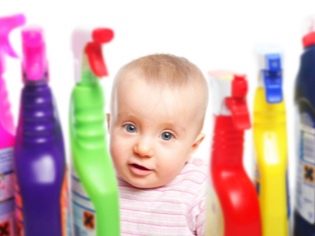The algorithm of gastric lavage in children
The fact that a child who shows signs of acute poisoning, you need to wash the stomach, everyone knows. But not many know exactly how to do it, especially when it comes to very young children.
These are the children most often prone to poisoning. Their stomach is sensitive, their immunity is weak, and the temptation to drag everything that is not well in their mouths is great. How to carry out this procedure correctly, we will tell in this article.
Why do I need a gastric lavage?
Gastric lavage may be necessary if the child is poisoned, if he swallows something poisonous, toxic, as well as overdose and drug poisoning.
Food poisoning - the most frequent in childhood.
In second place are medicinal poisoning. No matter how much adults try to hide medicines forbidden for them from babies, it is possible that investigative researchers will still find tempting bottles and pills and will definitely taste them. The same story with household chemicals, with soap, with cosmetics.
Washing the stomach will help bring out toxic contents and stop the further absorption of harmful substances in the body. After this procedure, as a rule, the child feels a significant relief, and the healing process is significantly accelerated.
When can I perform the procedure
You can wash the stomach of the child at the first sign of poisoning - nausea, headache, if there is no vomiting or it does not bring relief to the child.
Be sure to ensure that the child has no internal bleeding. (in the fecal masses and vomiting there should be no impurities and blood streaks).
The child at the time of the procedure must be in his right mind and memory, when you lose consciousness, you cannot wash the stomach on your own.
Sometimes the need to wash the stomach occurs not only in case of poisoning, but also in the event of intestinal obstruction, narrowing of the esophagus, as well as other diseases of the gastrointestinal tract.
Contraindications
In order to wash the baby's stomach at home, it is necessary that the baby is conscious. Unconsciousness is a contraindication, as is the presence of a convulsive syndrome.
For any hint of bleeding from the stomach, the procedure should be abandoned. You can not even try to wash the stomach of a child who has suffered severe burns of the larynx, esophagus and the stomach itself by swallowing a liquid alkaline or acidic composition.
If a child has congenital or acquired pathologies associated with impaired cerebral circulation, wash the stomach alone is impossible.
If the baby's pulse is unstable, the heart beats unevenly, the heart rhythm is disturbed, it is better to refuse manipulation.
If there are doubts about the possible contraindications available, call the Ambulance and wait for qualified specialists.
Home method
If necessary, wash the stomach at home using the manual method, which is called the "restaurant method". In this case, the child is abundantly watered with special solutions or plain water until the urge to vomit.
If the urge does not occur, the gag reflex is manually triggered by gently inserting the index finger into the baby’s mouth and lightly pressing the tongue root.
Quite difficult to perform can be such a washing a small child who is almost impossible to get to drink the right amount of liquid. In this case, you will need an assistant - a second adult person who will hold the baby until the first adult pours the solution into the child’s mouth with a large twenty-millimeter syringe without a needle.
Liquid is poured along the inner surface of the cheek so that the baby does not have the opportunity to spit it out. The solution for drinking or water should be warm, but not hot.
The algorithm of adult actions should be clear and coordinated:
- The child is placed in the correct position. The baby is on the hands, lying on its side, the older child is sitting or lying on its side. Such poses will not allow the child to choke on vomit, if they gush "fountain".
- A basin or other container to collect vomit is placed on the floor at face level.
- After drinking, stimulate vomiting, holding the head of the child over the container.
- Washing, if necessary, repeat until clean water begins to flow out.
It should be noted that this method does not allow to clear the stomach completely, but it is quite acceptable as a means of first emergency aid. The main thing is to correctly calculate the amount of fluid that is given during the manipulation of the child:
- newborn - 200 ml;
- children from one and a half months to half a year - 300-500 ml;
- children from 6 to 12 months - 500-700 ml;
- Children of the year - 1 liter + 100 x number of years.
Example: poisoned child in 2 years. He was given a volume of liquid equal to 1000 ml + 100x2 = 1200 ml. A child in 5 years, thus, to cleanse the stomach you need at least 1500 ml.
After washing, the child is allowed to rest for half an hour and begin to give him water for oral rehydration, which will prevent dehydration, and also restore the water-salt balance, which certainly suffers from vomiting. These tools include "Redigron", "Humana Electrolyte", "Smecta».
They are given warm, it is desirable that the temperature of the liquid was equal to the body temperature of the baby, you can drink in small portions with short breaks.
What to wash
For home washing it is possible to prepare a saline solution. To do this, you need the most common table salt. The concentration should not be too strong, it is enough to add 2 tablespoons of salt in 5 liters of water.
The same proportions should be followed when preparing a solution of soda. You can mix these solutions and give the child such a mixture.
Rinse with potassium permanganate should be with great care. Even a slight overdose of crystals, uneven mixing them can cause severe internal burns.
Without much experience of such manipulations, it is better to refuse the solution of potassium permanganate.
If you still want to use this particular antiseptic, important to follow the rules of cooking - A small number of crystals are diluted in water to a light pink color, after which the solution must be passed through a household carbon filter.
After washing after a few hours you can start taking enterosorbents. Such drugs should always be in the home first aid kit - "Enterosgel», Activated carbon and white coal, "Lactofiltrum».
Probe method
This method will allow you to more thoroughly clean the stomach, but you can not wash it through a probe at home. And not only because the probe is not in every apartment, but because the probe must be able to correctly enter without harming the baby.
Emergency ambulance doctors can use the probe, this technique is also used in medical institutions.
One of the parents will most likely have to assist the nurse during the manipulation.
The patient is seated or laid down. A baby breast is pre-wrapped with a sheet or a large thick diaper to avoid sudden movements, such violent behavior can result in injury to the esophagus and larynx.
The unconscious kid is laid on its side for washing. The parent’s task is to hold the baby, one adult’s hand lays on top of the hands of the offspring, the other should be placed on the baby’s forehead, the legs of the little patient are fixed between the knees of the helping adult. Everything else does the nurse.
First, the paramedic measures the distance to the stomach so that the probe sinks to the required depth. For this, the distance from the ear lobe to the tip of the nose and to the xiphoid process is measured (this is the very bottom of the sternum, the narrowest part of it).
The child opens his mouth with a spatula, if it does not come out, resort to the use of a special tongue holder and mouth gag. The probe is introduced parallel to the midline of the tongue.
If during the passage of the probe, the baby begins to choke, the procedure is interrupted and try again only after breathing is restored.
The solution is injected through a funnel or a syringe Janet without a piston. The funnel is slowly raised higher and then quickly and gently lowered below the level of the stomach. The contents of this body is poured into a pre-cooked basin.
The manipulation is repeated until the fluid leaving the stomach becomes clear and clean.
The volume of fluid for such washing is calculated by the formula "1 liter for 1 year of life." After manipulation, the vomit is sent to a laboratory test.
Washing performed for infants and children under 3 years old has its own characteristics. The health worker must carefully measure out his movements, for easier insertion of the probe, you can use special anesthetic sprays.
Common mistakes - how not to harm
Fluid temperature
The temperature of the flushing fluid is important. It is optimal if the solution has a temperature of 27-29 degrees.
Anything colder can provoke a sudden spasm of the food paths, all that is hot expands the blood vessels, as a result of which they become more permeable and the toxins begin to be absorbed at twice the speed.
Child placement
It is a mistake to force the child to flush the stomach over the toilet. Pose standing on your feet or on your knees in front of the toilet can cause vomit in the respiratory system.
It is important to collect the contents of the stomach in a basin when washing the house so that visiting doctors can evaluate the vomitus. This is necessary if the cause of the poisoning is not obvious, the parents do not know what the child ate or drank.
Medicines
Washing the stomach of the children do not need to carry out herbal decoctions and infusions, as advised by some experts in alternative medicine. It is not known how the substances contained in the decoction of the medicinal plant react with the contents of the stomach.
How to understand that the procedure was successful?
Whatever the method of freeing orgasm baby from unwanted substances after her child should feel much better. If investment does not occur, then either the procedure was carried out incorrectly or insufficiently, or the intoxication is already so strong that the child requires intravenous administration of drugs that will reduce the negative effects of toxins.
Visual instructions for washing the stomach with a probe, see below.










































